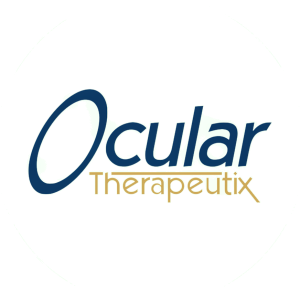Ocular Therapeutix™ Announces Positive Topline Phase 1 Data for AXPAXLI™ in Diabetic Retinopathy
No patients in the AXPAXLI group experienced worsening in DRSS compared to
AXPAXLI was generally well tolerated with no inflammation observed
Ocular intends to present the Phase 1 HELIOS study at an upcoming meeting
BEDFORD, Mass., April 18, 2024 (GLOBE NEWSWIRE) -- Ocular Therapeutix, Inc. (NASDAQ:OCUL) (“Ocular”), a biopharmaceutical company committed to enhancing people’s vision and quality of life through the development and commercialization of innovative therapies for wet age-related macular degeneration (wet AMD), diabetic retinopathy (DR), and other diseases and conditions of the eye, today announced positive topline results from the Phase 1 HELIOS study evaluating AXPAXLI versus a sham control in patients with moderately severe to severe non-proliferative diabetic retinopathy (‘NPDR’, NCT05695417) without diabetic macular edema (DME). Ocular plans to present the study results at an upcoming meeting.
Summary of Topline Phase 1 HELIOS Results:
- Safety: AXPAXLI was generally well tolerated with no inflammation observed including no incidence of iritis, vitritis or vasculitis
- Efficacy Results: 6 of 13 (
46.2% ) patients in the AXPAXLI group experienced a 1 or 2-step improvement in the Diabetic Retinopathy Severity Scale (DRSS) at 40 weeks, with 2 of the 6 having a 2-step improvement. No patients in the control group showed 1- or 2-step improvement at the same time point. No patients in the AXPAXLI group experienced any worsening in DRSS. 1 of 8 (12.5% ) in the control group experienced worsening in the DRSS at 40 weeks. - Durability of Effect: A single injection of AXPAXLI provided durable DRSS improvement up to 40 weeks
- Rescue medication: No patients in either arm received rescue medication
- Next Steps: Positive HELIOS results support decision to move directly to a Phase 3 study with AXPAXLI in patients with NPDR, pending discussions with the FDA
- Data Release: Ocular plans to present topline results from the HELIOS study at a future meeting
“We are pleased to announce positive topline data for AXPAXLI in patients with diabetic retinopathy. In an effort to get AXPAXLI to patients as quickly as possible, we unmasked this study, and based on the observed safety, efficacy results and durable treatment effect, we have decided to accelerate the DR program to Phase 3. We look forward to providing additional information on our timeline for next steps, including our plans to present these results at an upcoming meeting in the coming months,” said Jeffrey S. Heier, Chief Scientific Officer (CSO) of Ocular Therapeutix.
“It is promising that the efficacy signals seen to date in this Phase 1 study consistently favor AXPAXLI. These data demonstrated DRSS improvements and durability for up to 40 weeks,” said Dilsher Dhoot, MD. “In addition, these results, combined with the results in the AMD studies of AXPAXLI, make me even more enthusiastic to be a principal investigator in the SOL-1 study.” Dr. Dhoot, of California Retina Consultants, is an internationally recognized key opinion leader in retinal diseases.
About the HELIOS study
The Phase 1 HELIOS study is a multi-center, double-masked, randomized 2:1, parallel group clinical trial conducted at 10 centers in the U.S. The data set reported here is based on 21 evaluable subjects (one patient of the 22 enrolled subjects died from an unrelated event). The study was designed to evaluate the safety, tolerability and efficacy of AXPAXLI compared to a sham control in subjects with moderately severe to severe NPDR without Diabetic Macular Edema (DME). The primary endpoint of the study is frequency of treatment emergent adverse events (TEAEs). Secondary study endpoints include changes in the DRSS, changes in best corrected visual acuity (BCVA), changes in central subfield thickness compared to baseline, and the portion of subjects receiving rescue therapy.
About AXPAXLI™
AXPAXLI is an investigational bioresorbable, hydrogel implant incorporating axitinib, a small molecule, multi-target, tyrosine kinase inhibitor with anti-angiogenic properties, being evaluated for the treatment of wet AMD, DR and other retinal diseases.
About Ocular Therapeutix, Inc.
Ocular Therapeutix, Inc. is a biopharmaceutical company committed to enhancing people’s vision and quality of life through the development and commercialization of innovative therapies for wet age-related macular degeneration (wet AMD), diabetic retinopathy (DR), and other diseases and conditions of the eye. AXPAXLI™ (axitinib intravitreal implant, also known as OTX-TKI), Ocular’s product candidate for retinal disease, is based on its ELUTYX™ proprietary bioresorbable hydrogel-based formulation technology. AXPAXLI is currently in the first of two planned pivotal Phase 3 trials for wet AMD, the SOL-1 trial, and a Phase 1 clinical trial for the treatment of NPDR. The clinical portfolio also includes PAXTRAVA™ (travoprost intracameral implant, also known as OTX-TIC), currently in a Phase 2 clinical trial for the treatment of primary open-angle glaucoma or ocular hypertension.
Ocular’s expertise in the formulation, development and commercialization of innovative therapies of the eye and the ELUTYX platform supported the development and launch of its first commercial drug product, DEXTENZA®, an FDA-approved corticosteroid for the treatment of ocular inflammation and pain following ophthalmic surgery and ocular itching associated with allergic conjunctivitis. ELUTYX is also the foundation for two other clinical-stage assets, OTX-CSI (cyclosporine intracanalicular insert) for the chronic treatment of dry eye disease and OTX-DED (dexamethasone intracanalicular insert) for the short-term treatment of the signs and symptoms of dry eye disease, as well as several preclinical programs.
Follow us on our website, LinkedIn or X.
DEXTENZA® is a registered trademark of Ocular Therapeutix, Inc. AXPAXLI™, PAXTRAVA™, and ELUTYX™ and Ocular Therapeutix™ are trademarks of Ocular Therapeutix, Inc.
Forward-Looking Statements
Any statements in this press release about future expectations, plans, and prospects for the Company, including the development and regulatory status of the Company’s product candidates, including the timing, design, and enrollment of the Company’s Phase 3 trials of AXPAXLI (also called OTX-TKI) for the treatment of wet AMD and the Company’s planned Phase 3 clinical development program of AXPAXLI for the treatment of diabetic retinopathy; the Company’s plans to advance the development of AXPAXLI, PAXTRAVA and its other product candidates; the potential utility of any of the Company’s product candidates; the sufficiency of the Company’s cash resources; and other statements containing the words “anticipate”, “believe”, “estimate”, “expect”, “intend”, “goal”, “may”, “might”, “plan”, “predict”, “project”, “target”, “potential”, “will”, “would”, “could”, “should”, “continue”, and similar expressions, constitute forward-looking statements within the meaning of The Private Securities Litigation Reform Act of 1995. Actual results may differ materially from those indicated by such forward-looking statements as a result of various important factors. Such forward-looking statements involve substantial risks and uncertainties that could cause the Company’s preclinical and clinical development programs, future results, performance or achievements to differ significantly from those expressed or implied by the forward-looking statements. Such risks and uncertainties include, among others, the timing and costs involved in commercializing DEXTENZA or any product or product candidate that receives regulatory approval; the ability to retain regulatory approval of DEXTENZA or any product or product candidate that receives regulatory approval; the initiation, design, timing, conduct and outcomes of clinical trials, including the SOL-1 trial, the HELIOS trial, and the planned Phase 3 clinical development program of AXPAXLI for diabetic retinopathy as well as the Company’s other ongoing clinical trials; the risk that the FDA will not agree with the Company’s interpretation of the written agreement under Special Protocol Assessment for the SOL-1 trial; the risk that even though the FDA has agreed with the overall design of the SOL-1 trial, the FDA may not agree that the data generated by the SOL-1 trial supports potential marketing approval; uncertainty as to whether the data from earlier clinical trials will be predictive of the data of later clinical trials, particularly later clinical trials that have a different design or utilize a different formulation than the earlier trials, or whether preliminary or interim data from a clinical trial will be predictive of final data from such trial; availability of data from clinical trials and expectations for regulatory submissions and approvals; the Company’s scientific approach and general development progress; uncertainties inherent in estimating the Company’s cash runway, future expenses and other financial results, including its ability to fund future operations, including clinical trials; the Company’s existing indebtedness and the ability of the Company’s creditors to accelerate the maturity of such indebtedness upon the occurrence of certain events of default; the Company’s ability to enter into strategic alliances or generate additional funding on a timely basis, on favorable terms, or at all; and other factors discussed in the “Risk Factors” section contained in the Company’s quarterly and annual reports on file with the Securities and Exchange Commission. In addition, the forward-looking statements included in this press release represent the Company’s views as of the date of this press release. The Company anticipates that subsequent events and developments will cause the Company’s views to change. However, while the Company may elect to update these forward-looking statements at some point in the future, the Company specifically disclaims any obligation to do so, whether as a result of new information, future events or otherwise, except as required by law. These forward-looking statements should not be relied upon as representing the Company’s views as of any date subsequent to the date of this press release.
Investors
Ocular Therapeutix
Donald Notman
Chief Financial Officer
dnotman@ocutx.com
Joyce Allaire
LifeSci Advisors
jallaire@lifesciadvisors.com







